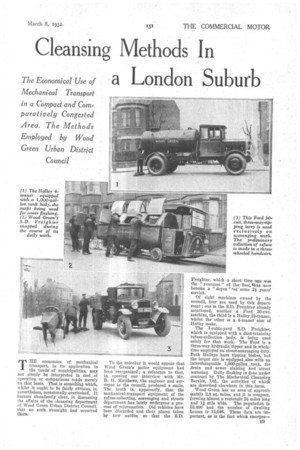Cleansing Methods In a London Suburb
Page 123

Page 124

If you've noticed an error in this article please click here to report it so we can fix it.
The Economical Use of Mechanical TransPort in a Compact and Comparatively Congested Area. The Methods Employed by Wood Green Urban District Council
HE economics of mechanical transport, in its application to the needs of municipalities, may not simply be interpreted in cost of operation or comparisons made merely on that basis. That is something which, whilst it ought to be fairly obvious, is, nevertheless, occasionally overlooked. It became abundantly clear, in discussing the affairs of the cleansing department of Wood Green Urban District Council, that no such oversight had occurred there. To the onlooker it would appear that Wood Green's motor equipment had been reorganized ; a reference to that, in opening our interview with Mr. R. H. Matthews, the engineer and surveyor to the council, produced a smile. The truth is, apparently, that the mechanical-transport equipment of the refuse-collecting, scavenging and streets department has lately undergone a process of rejuvenation. Old vehicles have been discarded and their places taken by new outfits, so that the S.D. Freighter, which a short time ago was the "youngest" of thei fleet,Ahas now become a "doyen "of 'some 2i years' service.
Of eight machines owned by the council, four are used by this departmeat; one is the S.D. Freighter already mentioned, another a Ford 30-cwt. machine, the third is a Halley 21-tonner, whilst the other is a 4-tonner also of Halley make.
The 7-cubic-yard S.D. Freighter, which is equipped with a dust-retaining refuse-collection body, is being used solely for that work. The Ford is a three-way hydraulic tipper and is wholetime employed on street-scavenging duty. Both tialleys have tipping bodies, but the larger one is equipped also with an interchangeable 1,000-Aallon. tank, for drain and sewer sluiciiag and street watering. Gully flushing is done under contract by The Mechanical Cleansing Service, Ltd., the activities of which are described elsewhere in this issue.
Wood Green has an area of approximately 2.8 sq. miles, and it is compact, forming almost a rectangle 2+ miles long and 1-1 mile wide. The population is 53,400 and the number of dwelling houses is 12,643. These data are important, as is the fact which emerges- namely, that the longest lead to the destructor is only a little over a mile. That makes it cheaper to use horsed transport for the bulk of the refuse collection.
The S.D. Freighter is employed on the fringe of the district, with horses and carts in the central area. A thorough test of the S.D. Freighter was made some three years ago, to ascertain if a complete change-over to motors was advisable. The upshot of the investigation was the decision to buy only the S.D. Freighter, and to carry on after the fashion just described.
A scrutiny of the accounts over a period, covering only the use of horses and the use of horses and motors, and relating to refuse-collection operation, discloses the fact that there has been no alteration in the cost per ton. The average remains at about 15s. 6d., of which Ss. 9d. is for collection and 6s. 9d. for destruction. Economically, however, the innovation has more than justified itself.
The system of collection was reorganized when the S.D. Freighter was put into service (would that all motor users could be made to see the Wisdom of that course), and the result has been the elimination of occasional irregularities of collection, a speeding up of the work generally and greater elasticity in dealing with refuse from .shops.
The actual cost of the S.D. Freighter is £2 per day. The scavenging is carried out ahnost entirely by the Ford 30-cwt. vehicle. The district is divided into 15 areas, in each of which the streets are swept by a man who shovels the refuse into a handcart. When that is full the load is deposited at the roadside in a heap, whence it is transferred to the Ford. The latter makes a complete tour of the district three dines per day, picking up, therefore, 45 times. The Ford covers about 30 miles per day at a cost of 11 7s. 6d.
The cost of scavenging for the past three years and the mileage of streets traversed are set out in the accompanying table. The expenditure includes the cost of the Ford, already stated to be £1 7s. 6d. per day, the wages of the 15 scavengers, the upkeep of the handcarts and certain chute charges.
The two Halleys are employed on general haulage, street repairs and works, and, with the tank body, on drain and sewer flushing, as well as on street watering. The 2i-ton machine costs £2 2s. per day, including in that sum the wages of one man. The 4tonnes involves an expenditure of £3 per day, two men being employed in conjunction with this machine.
Both the Halleys are new, having been purchased last December and put into service at the commencement of this year. They replaced two others of the same make, but both of 3i-ton capacity. It is of interest to note that the older machines, each • with two men, cost £2 14s. per day per vehicle.












































































































































































